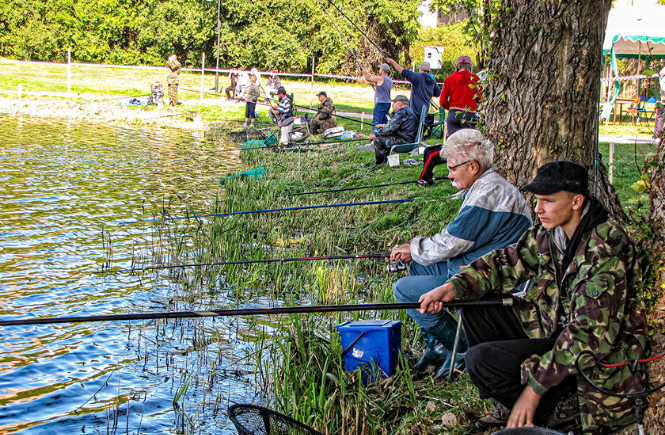A part of the Olsztyn Lakeland southeast of Olsztyn is the perfect place for those wanting to seek solace from the commotion and hubbub of the city, revelling in the values of nature and recreational tourism.
Pasym is a small town that was established in 1386. It has a population of 2,600 and its merit is its size as it can be quickly navigated. There is an exceptional and unusual for Varmia and Masuria neo-Gothic Town Hall in the town centre. As stated on the town’s website www.pasym.pl: “Built on a rectangular plan, the six-axis building has a biaxial avant-corps that advances into low four-sided towers. The entire building is crowned with a crenelation with small towers in the corners”. There are also two churches in Pasym. The older is an Evangelical-Augsburg church from the 14th century with interesting interiors (a Mannerist altar dating back to 1673 and polychromed in 1714, a pulpit from 1680, an organ front from 1705, as well as Gothic pews from the 15th century and Mannerist pews from the 17th century). It has been a Lutheran Church since the Reformation of the 16th century. Napoleon Bonaparte stayed the night in its clergy house on 2nd February 1807. The younger church (Roman Catholic) was erected on the site of the castle in 1863 and is a fine example of cooperation between Catholics and Evangelicals. Langermann, the owner of the brickyard and himself an Evangelical generously provided bricks for the building free of charge and offered a parcel of land for the cemetery, whereas the stones for the foundations were donated by local landowners of both religious denominations. The border separating Evangelical Masuria from Catholic Masuria lies several kilometres from Pasym. The system of urban buildings has a medieval layout with the remains of the town walls. The Pasym Organ and Chamber Music Concerts are a cultural attraction.

zawody wędkarskie / fot. UMiG Pasym 
Wyścigi smoczych łodzi na jeziorze Kalwa / fot. UMiG Pasym
The town is situated by Lake Kalwa (1,383 acres), and there are other lakes in the region: Lake Sasek Wielki (2,150 acres), Lake Kośno (1,364 acres), Lake Leleskie (1,047 acres), Lake Serwent (605 acres), Lake Gromskie (593 acres), and others. They offer water recreation activities and angling/fishing and are rich in fish: bream, pike, perches and roach (ed’s note – more about the fishing opportunities in Varmia and Masuria on www.mazury.travel/wedkuj). This is a protected landscape area of the Olsztyn Lakeland and the Napiwodzko-Ramucka Forest as well as the Green Lungs of Poland. Pine woods are found here with high stocks of game species (elks, roe deer, red deer, boars, raccoon dogs, foxes, squirrels, and badgers) and many bird species. It is a true haven for mushroom foraging in summer and autumn.

Pasym z lotu ptaka / fot. © Jacek Podwysocki / Shutterstock.com 
fot. UMiG Pasym 
Pasym trasa rowerowa Kalwa / fot. UMiG Pasym
Cycling enthusiasts have 9 circuit trails to enjoy: “Czarci Kamień” (20 km), “Kamień Hindenburga” (30 km), “Kośno” (35 km), “Kalwa” (25 km), “Graszk” (30 km), “Czarny Bocian” (20 km), “Babska Chata” (35 km), “Chamedafne Północna” (23 km), and “Pajtuński Młyn” (35 km). It is worth cycling across Dźwierzuty (35 km; some of the train is still under construction) to Szczytno – the town of the legend of Polish rock, Krzysztof Klenczon, Polish composer, singer and guitarist, and home to the Higher Police Academy as well as a revitalised Teutonic castle, which is the seat of the Masurian Museum established in 1925 (www.muzeumszczytno.art.pl). Those wanting to take a tour of the town can take one of the Masurian “Pofajdok” (Polka Polish folk dance) Trails, with 14 trails to choose from. Before the War, Szczytno was a strong mainstay of Polishness. There are many historic buildings here with an interesting history (www.miastoszczytno.pl) like, for instance, the former Seasonal Agricultural School for rural youth who studied there during the winter months (from November to March). When returning to Pasym by train, the well-preserved station complex dating back to 1883 can also be seen.

Wnętrze kościoła ewangelickiego / fot. arch. UMWWM 
Wnętrze kościoła rzymskokatolickiego / fot. arch. UMWWM
The village of Rudziska Pasymskie is a mere 5 km away from Pasym. This was where a pre-1945 tourist complex and guesthouse could be found with a ski jump, chairlift, pier, and numerous cafés. This complex was so big that one of the streets in Berlin that led to the Olympic Stadium in 1936 was named Passenheimer Straße. After the War, it hosted the Masurian People’s University established by Karl Małłek, Masurian activist and teacher. It later housed the Training and Leisure Centre of the Polish Rural Youth Union and the Polish Teacher’s Union. The facility was left in ruins by the fire that engulfed it in 1987.

Warsztaty tkactwa / fot. UMiG Pasym 
Panorama z widokiem na kościół ewangelicki w Pasymiu / fot. © iwciagr / Shutterstock.com
Pasym lies 20 km from Szczytno and 30 km from Olsztyn, with convenient road and rail connections (Olsztyn – Szymany Lotnisko or Olsztyn – Pisz – Ełk route). Its extensive accommodation options mainly comprise guest rooms and holiday homes, but there is also the large Ośrodek Wypoczynkowy Kalwa Resort with year-round chalets, a pool, and slides – www.kalwa-energopol.pl).
It is by all means suitable for the modern traveller and an excellent weekend (and longer) getaway.
Stanisław Harajda
It is with deep sorrow and a sense of profound loss that we bid farewell to our fellow editorial colleague, Stanisław Harajda, who passed away in March of this year before the latest issue of the magazine was published. He still managed to write two texts, contributing to the latest issue (https://lovewm.pl/en/oases-of-serenity-and-nature-in-cittaslow-towns/ and https://lovewm.pl/en/regional-variety/), thus, leaving us with mere vestiges of his extensive knowledge and great passion for Varmia and Masuria. LOVE WM will never be the same without Staszek!




